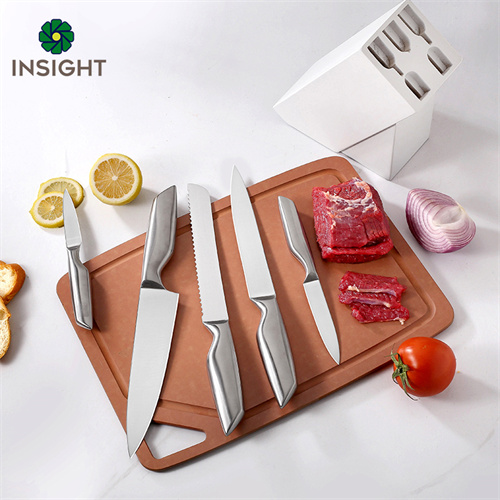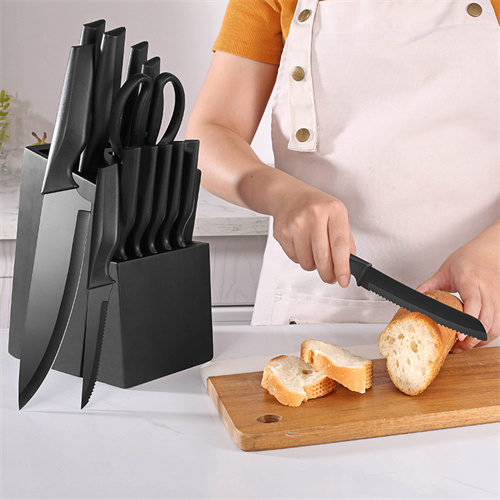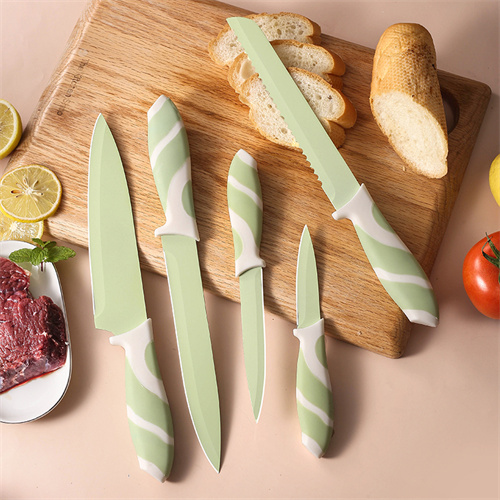

Views: 9000 Author: sales@insightknife.com.cn Publish Time: 2025-01-21 Origin: Site








Content Menu
● Understanding Kitchen Knife Blades
>>> Stainless Steel
>>> Ceramic
● Blade Shapes and Their Impact on Performance
>> Chef's Knife
>> Paring Knife
>> Bread Knife
>> Cleaver
>> Thin Blades
>> Thick Blades
● Edge Types and Their Effects
>> Sharpening
>> Cleaning
>> Storage
● Frequently Asked Questions regarding Kitchen Knife
>> 1. What is the best material for kitchen knife blades?
>> 2. How often should I sharpen my kitchen knives?
>> 3. What is the difference between a chef's knife and a Santoku knife?
>> 4. Can I use a serrated knife for cutting vegetables?
>> 5. How should I store my kitchen knives to maintain their sharpness?
When it comes to kitchen knives, the blade type is a crucial factor that significantly influences cutting performance. Understanding the various blade types can help you choose the right knife for your culinary needs, enhancing both your cooking experience and the quality of your food preparation. This article delves into the different kitchen knife blade types, their unique characteristics, and how they impact cutting performance.
Kitchen knives come in various shapes and sizes, each designed for specific tasks. The blade type affects not only the knife's performance but also its handling, maintenance, and overall effectiveness in the kitchen. Selecting the right knife can make a significant difference in the ease and efficiency of food preparation, allowing for a more enjoyable cooking experience.
The material of the blade is one of the primary factors that determine its performance. Common materials include stainless steel, carbon steel, and ceramic. Each material has its advantages and disadvantages, influencing factors such as sharpness, edge retention, and resistance to corrosion. Understanding these materials can help you make informed decisions when purchasing kitchen knives.
Stainless steel is the most popular choice for kitchen knives due to its excellent corrosion resistance and ease of maintenance. It holds a sharp edge well and is relatively easy to sharpen, making it a practical option for both home cooks and professional chefs. However, it may not retain its edge as long as high-carbon steel, which can lead to more frequent sharpening. Additionally, stainless steel knives are often available in various grades, with higher-quality options providing better performance and durability.

High-carbon steel blades are known for their ability to hold a sharp edge longer than stainless steel. They are easier to sharpen, allowing for quick maintenance when needed. These blades are favored by professional chefs for their superior cutting performance, especially when precision is required. However, high-carbon steel requires more maintenance to prevent rust and corrosion, which can be a drawback for some users. Regular oiling and proper storage are essential to keep these knives in optimal condition.
Ceramic blades are incredibly sharp and maintain their edge for a long time, making them an attractive option for those who prioritize sharpness. They are lightweight and resistant to rust, which adds to their appeal. However, ceramic knives can be brittle and prone to chipping if not handled carefully. They are ideal for slicing fruits and vegetables but are not suitable for cutting through bones or hard materials. Understanding the limitations of ceramic knives is crucial for ensuring they are used effectively in the kitchen.
The shape of a knife blade plays a significant role in its cutting performance. Different shapes are designed for specific tasks, and understanding these can help you select the right knife for your needs. The design of the blade influences how the knife interacts with food, affecting the ease and precision of cuts.
The chef's knife is a versatile tool with a broad blade that tapers to a point. It is designed for a variety of tasks, including chopping, slicing, and dicing. The curved edge allows for a rocking motion, making it ideal for mincing herbs and garlic. A well-balanced chef's knife can significantly reduce fatigue during prolonged use, making it a staple in both professional kitchens and home cooking environments. The versatility of the chef's knife means it can often replace several other knives, making it a valuable addition to any kitchen.
The Santoku knife features a flat edge and a slightly curved blade, making it excellent for slicing vegetables. Its design allows for precise, straight cuts, and the granton edge (dimples) helps prevent food from sticking to the blade. This knife is particularly popular in Asian cuisine, where precision and speed are essential. The Santoku knife's lightweight design and ergonomic handle also contribute to its ease of use, making it a favorite among home cooks and culinary professionals alike.
A paring knife has a small, pointed blade that is perfect for intricate tasks such as peeling and trimming. Its size allows for greater control, making it ideal for detailed work. Paring knives are often used for tasks that require precision, such as deveining shrimp or creating decorative garnishes. The versatility of the paring knife makes it an essential tool for any cook, as it can handle a wide range of tasks that larger knives may struggle with.
The bread knife features a serrated edge that allows it to cut through crusty bread without crushing it. The saw-like teeth grip the bread, making it easy to slice without applying too much pressure. This design is particularly beneficial for artisan breads with thick crusts, as it prevents the loaf from being squished. A good bread knife can also be used for slicing cakes and other soft foods, showcasing its versatility in the kitchen.
The cleaver is a heavy-duty knife with a thick blade designed for chopping through bones and tough cuts of meat. Its weight and thickness provide the necessary force for heavy-duty tasks, making it an indispensable tool in many kitchens. Cleavers can also be used for crushing garlic or ginger, showcasing their multifunctionality. However, due to their size and weight, they require proper technique to ensure safe and effective use.

Blade thickness is another critical factor that affects cutting performance. Thicker blades are generally more robust and can handle heavy-duty tasks, while thinner blades excel in precision cutting. Understanding the implications of blade thickness can help you choose the right knife for specific culinary tasks.
Thin blades are ideal for delicate tasks such as slicing fish or vegetables. They allow for precise cuts and are often preferred for tasks that require finesse. The lightweight nature of thin blades can reduce hand fatigue during extended use, making them suitable for intricate work. However, thin blades may not be suitable for heavy-duty chopping, as they can bend or break under excessive pressure.
Thicker blades provide stability and strength, making them suitable for chopping through tough materials. They are often used in cleavers and heavy-duty knives, where durability is essential. The added weight of thick blades can also aid in cutting through dense foods, allowing for more efficient preparation. However, the trade-off is that thick blades may not offer the same level of precision as their thinner counterparts, making them less ideal for intricate tasks.
The edge of a knife can be straight, serrated, or a combination of both. Each edge type has its advantages and is suited for different tasks. Understanding these edge types can help you select the right knife for your specific needs.
A straight edge is ideal for clean, precise cuts. It is commonly found on chef's knives and paring knives, making it versatile for various kitchen tasks. The smooth edge allows for easy slicing through soft foods, such as meats and vegetables, without tearing. Straight edges are also easier to sharpen, making maintenance straightforward for home cooks and professionals alike.
Serrated edges are perfect for cutting through tough surfaces, such as bread or tomatoes. The teeth grip the material, allowing for easy slicing without crushing. This design is particularly beneficial for foods with a hard exterior and soft interior, as it minimizes damage to the food. Serrated knives are often used for tasks that require a sawing motion, making them essential for certain culinary applications.
A combination edge features both straight and serrated sections, providing versatility for different cutting tasks. This type of blade is practical for those who want a do-it-all knife, as it can handle a variety of foods and cutting techniques. The combination edge allows for seamless transitions between tasks, making it a valuable addition to any kitchen arsenal.
Proper maintenance is essential for ensuring the longevity and performance of kitchen knives. Different blade types require different care techniques. Understanding how to care for your knives can help you maintain their performance and extend their lifespan.
Regular sharpening is necessary to maintain a knife's cutting performance. Stainless steel knives can be sharpened with a whetstone or honing rod, while high-carbon steel knives may require more frequent sharpening. Knowing how to sharpen your knives correctly is crucial for maintaining their edge and ensuring optimal performance. Additionally, using the right sharpening tools can make the process easier and more effective.
Most kitchen knives should be hand-washed and dried immediately to prevent rust and corrosion. Avoid putting knives in the dishwasher, as the heat and moisture can damage the blade. Proper cleaning techniques can help maintain the knife's appearance and performance, ensuring it remains a reliable tool in your kitchen. Using mild soap and warm water is often sufficient for cleaning, followed by thorough drying to prevent moisture buildup.
Proper storage is crucial for maintaining a knife's edge. Using a knife block, magnetic strip, or blade guards can help protect the blade from damage and keep it sharp. Storing knives properly not only prolongs their lifespan but also enhances safety in the kitchen. Keeping knives organized and easily accessible can improve efficiency during food preparation, allowing for a smoother cooking experience.
Understanding the different blade types and their impact on cutting performance is essential for anyone who spends time in the kitchen. By selecting the right knife for your needs and maintaining it properly, you can enhance your cooking experience and achieve better results in your culinary endeavors. Whether you are a professional chef or a home cook, the right kitchen knife can make all the difference in your food preparation. Investing time in understanding your knives will ultimately lead to improved skills and greater enjoyment in the kitchen.

The best material for kitchen knife blades depends on your needs. Stainless steel is popular for its corrosion resistance and ease of maintenance, while high-carbon steel is favored for its ability to hold a sharp edge longer. Ceramic blades are excellent for maintaining sharpness but can be brittle. Each material has its advantages, so the choice depends on the intended use and personal preference.
The frequency of sharpening kitchen knives depends on usage. For home cooks who use their knives regularly, sharpening every few months is typically sufficient. Professional chefs may sharpen their knives weekly or even daily, depending on the intensity of use. Regular honing can also help maintain the edge between sharpenings.
A chef's knife has a broad, curved blade that allows for a rocking motion, making it versatile for various tasks like chopping, slicing, and dicing. In contrast, a Santoku knife features a flatter blade with a slight curve and often has a granton edge to prevent food from sticking. The Santoku is particularly effective for slicing vegetables and is popular in Asian cuisine.
While serrated knives are primarily designed for cutting through tough surfaces like bread, they can also be used for certain vegetables, especially those with a hard exterior and soft interior, such as tomatoes. However, for precision tasks like slicing cucumbers or carrots, a straight-edged knife is generally more effective.
To maintain the sharpness of kitchen knives, store them in a knife block, on a magnetic strip, or in blade guards. Avoid storing knives loose in a drawer, as this can cause the blades to dull or become damaged. Proper storage not only protects the blades but also enhances safety in the kitchen.
What Is The Difference between A Carving Knife And A Chef's Knife?
How Often Should I Sharpen My Bread Knife To Maintain Optimal Performance?
How Do Different Blade Shapes Affect The Performance of A Chef's Knife?
What Are The Best Practices for Storing And Caring for Steak Knives?
Are There Specific Types of Steel That Are Better for Steak Knives?